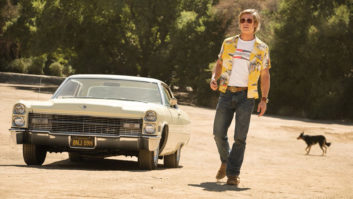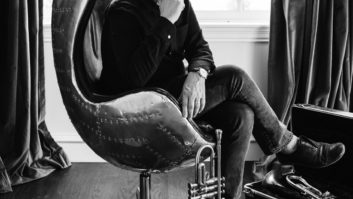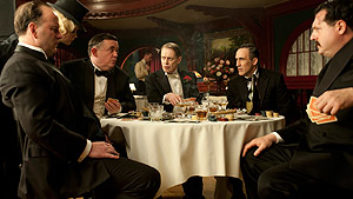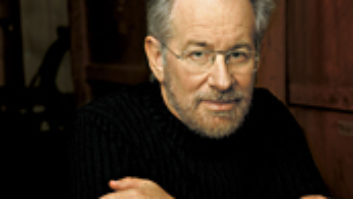Clean, clear audio: It’s central to the success of CBS’ hit series, CSI: Crime Scene Investigation. Without clear audio, the complex CSI plot line would be lost, as would the smart, snappy dialog. Fortunately, CSI has the right man behind its audio board: Mick Fowler, a music-trained mixing veteran, who’s been with CSI since its inception.
For four days of each episode’s eight-day shoot, Fowler does his work in the predictable confines of Santa Clarita studios in Valencia, Calif. “After two seasons, we’re pretty used to these studios, their acoustics and how well wireless works in them,” he says. “We now know what to expect.”
However, for the other four days, Fowler can be anywhere from LAX Airport to the middle of the desert. How does he cope, what equipment does he take with him and (of most interest to this writer, who’s struggled with this problem time and time again) how does he hide wireless mics on his actors so there’s no clothing rustle?
HAVE AUDIO BOARD, WILL TRAVEL
As a veteran of TV series such as NBC’s Profiler and Fox’s Action, Fowler is accustomed to location work, which is why he’s developed a basic audio setup that accompanies him wherever he goes.
“I start with an 8-channel Soundcraft GP1 board, soon to be a Zaxcom Cameo,” says Fowler. “Into this, I input audio from up to eight wireless Sanken microphones: lavalier, boom or a combination of both. The transmitter units are Lectrosonics: four operating in VHF, and four in UHF.”
Whenever possible, Fowler relies on boom man Donovan Dear, whom he describes as “one of the best in the business.” To make sure Fowler’s audio gets back to the board, Dear is equipped with a 250-milliwatt transmitter, which is one-and-a-half times more powerful than most wireless units.
Fowler records audio on a 4-track Zaxcom Deva hard disk recorder. “As we record, we automatically ‘mirror’ the audio to a DVD. At the end of the day, both the DVD and the hard disk are sent to post-production.” For backups, Fowler uses “a good ol’ fashioned analog Nagra TC reel-to-reel. It’s so reliable that it almost never lets you down. And, being analog, the Nagra isn’t prey to the various bugs that can affect digital files.”
Finally, there’s wireless intercom. Fowler and Dear are linked via a Lectrosonics IFB system, while the show’s director has a Comtek link that lets him hear the audio mix while it’s recording.
In general, Fowler sites his audio station as far away from the action as possible. “Forget the romanticism of being close to the actors on set,” he says with a laugh. “I’ve been doing this a long time.” As he points out, being far away means that there’s less equipment and fewer people cluttering up the set, “which makes everyone happier.”
TRICKS OF THE TRADE
For Fowler, recording clean, intelligible audio is what this job is all about. “CSI is dialog-driven,” he explains. “There are lots of clues provided in the audio. The viewers are very smart; they want to hear all of the forensic details so that they can solve the crime themselves.” However, as anyone who’s ever done location audio knows, the combination of clothing rustle, varying audio levels, microphone cross talk, wireless dropout and background noise can often lead to distorted or unintelligible audio, or both. Especially both.
To get intelligible audio, Fowler records dialog “as if I’m standing right beside the actors. It doesn’t matter whether the actors themselves are standing in close-up or 100 feet away in an establishing shot. The audience must feel like they’re eavesdropping on the conversation.”
Wherever possible, Fowler gives Dear the task of capturing location audio using Neumann microphones, specifically KMR 81 and 82 models. “I love Neumanns,” says Fowler. “The sound on them is so great.” In situations that demand the use of wireless microphones, Fowler is very, very careful about where he places them.
On CSI‘s female characters (Catherine Willows and Sara Sidle), the placement is relatively simple. “It’s probably not politically correct to say this,” Fowler says, “but I take advantage of Marg Helgenberger’s and Jorja Fox’s physiology and place the mics between their breasts using surgical tape. Needless to say, I have the actresses do the mic placement themselves. Gary Dourdan — who plays Warrick Brown — has a good set of pecs. So I use the same technique on him, too.”
When surgical taping isn’t possible, Fowler and Dear have other ways to hide lavalier mics. Sometimes they hide them in buttonholes. Other times, they use a combination of “vampire clips” and putty to attach them to an actor’s clothing. In all instances, their goal is to balance clothing rustle against invisibility to end up with a mic placement that does the job.
MUSICAL EXPERIENCE HELPS
Fowler got his start in London in the ’80s, working as house producer for Philips Records. “Back then, I had to mix up to 24 tracks,” he recalls. “The fun part was to balance all of the separate elements — drums, voices, instruments — and produce a cohesive whole that sounded right. Today, I take the same approach when I’m recording CSI. My goal is to deliver a finished product, not a series of ingredients. The reason is simple: I like to mix.”
For example, whenever Fowler is recording a group of CSI actors in, say, a hallway scene, “I’m riding the faders.” As soon as one actor’s finished speaking, Fowler pulls his channel down, which prevents cross talk and also helps keep his levels balanced. Of course, sometimes he adds an open mic at the back of the room to capture the right reverb.
THE NOT-SO-FUN STUFF
Every location job has its challenges. In CSI’s case, the biggest one is background noise. Actually, the noise itself isn’t a big problem, as long as the viewer understands the reason for it. For instance, when there was a sequenced shot inside LAX Airport, the audience could see why there was so much ambience on the soundtrack. But during a shoot inside a strip club, which was right next to a freeway, “You could occasionally hear traffic noises on the audio track,” says Fowler. “Trouble is, there was no reference to the freeway in the script. So the audience wasn’t able to understand and then dismiss this ambience.”
When noise gets to be too much of a problem, CSI‘s actors remedy the problem by re-doing the audio in the studio. However, this takes time and is something Fowler does his best to avoid.
Script changes also present minor problems. Despite what the viewers might think, scripts are not written in stone. In fact, CSI‘s scripts can be in flux right up to the moment of taping. Typically, changes are driven by the actors themselves. “They have a solid understanding of their characters and how they react in certain situations,” explains Fowler. “Of course, the scripts have to be changed to take their feedback into account.”
To cope with such challenges, Fowler sits in on all of the rehearsals, keeping a sharp eye on each episode’s evolution. During taping, Fowler keeps a copy of the latest script on a music stand. With each fader assigned to an individual actor, he then “plays” the mix, reading along and making his moves in accordance with the actors’ lines.
Risky? Yes, but it’s also the best part of the job, as far as Fowler is concerned. “Sometimes I’ve got two boom mics and six lavaliers running capturing a last-minute script change, or even an unscripted ad lib. To me, this kind of organized chaos smacks of my old days in music mixing. It’s just plain fun!”
The quality of Mick Fowler’s location work speaks for itself. Tune into CSI, and you can count on hearing everything the actors say, every time. No matter where they happen to be.
James Careless is a freelance writer based in Ottawa, Canada. He has 21 years of experience in audio, radio and TV production.





